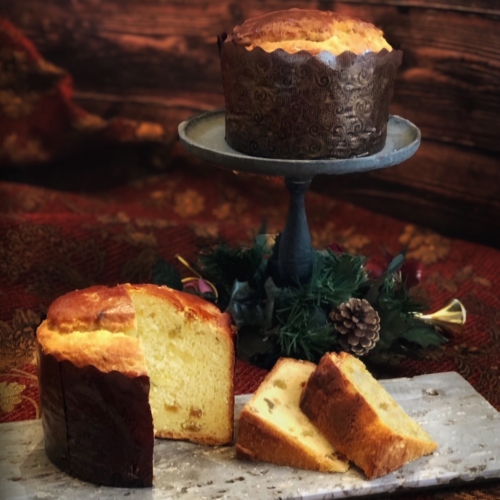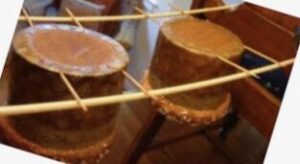

Classic Panettone
This Panettone recipe, of all my Father's recipes (so far that is) has taken the longest to develop. To my recollection, he never made this while we had our family bakery in Northern California, but did make it during his apprenticeship in the 1930's. Several versions appear in his journal. Some had the dough resting overnight in the refrigerator, some had three risings, others had two. There were small changes in the amounts of butter and sugar, but none were overly sweet and none had nuts. So, for home use, I find this to be the easiest, and can be made in a day. The extract - Fiori di Sicilia can be found in some specialty stores, but you can also find it online. It is an important component in this recipe if you want that hard to detect aroma and flavor you find in top quality imported brands. Another important ingredient is good quality peel. You may find very fine orange, lemon and citron at Italian delicatessens, or again, on line. I do apologize for the lateness in posting this recipe. If you don't have time to make it this season, I hope you give it a try for the next. Try it toasted, or as French Toast or even in a bread pudding. It's wonderful!
Equipment
- 3 1 pound Panettone molds or several smaller
Ingredients
- 5 cup King Arthur unbleached all purpose flour (600g)
- 2 packets active dry yeast (14g)
- 1 cup warm (95°) water (237ml)
- 4 large grade A eggs
- 1/2 cup granulated sugar (100g)
- 1 tsp salt (6g)
- 2 tsp Fiori di Sicilia (8.5g)
- 11 tbsp unsalted butter (157g)
- 1/2 cup candied orange peel (70g)
- 1/2 cup candied lemon peel (70g)
- 1/2 cup citron peel (70g)
- 1/2 cup golden raisins (70g)
- 1/2 cup dark raisins (70g)
Instructions
- Mix one cup of flour (120g), the Active yeast, and the warm water in a bowl. It should the consistency of pancake batter. Cover with a sheet of plastic wrap and place in a warm place. Let it set for about 20 minutes until the yeast becomes active.
- Place the butter and sugar in the bowl of your mixer. Using the paddle attachment, mix until combined. Now add your room temperature eggs, one at a time. Completely incorporate each before adding the next. Add another cup (120g) of flour, the salt, candied fruit and Fiori di Sicilia and mix until completely combined.
- Switch attachments to the bread hook. Add the remaining 3 cups (360g) of flour and the yeast sponge. Knead at low speed for 5 minutes. The mixture will be very sticky, and you should stop and scrape down the sides and bottom at least once during this 5-minute kneading time.
- Scoop the dough into a bowl large enough to hold the dough as it doubles in size. Cover with plastic wrap and set in a warm spot to rise. Depending on the temperature, it will take one to two hours to double.
- After the dough has doubled, scrape it out onto a floured work surface. Cut the dough into three equal pieces, roll each into a ball shape, and place in your one-pound Panettone baking molds. If your containers are different sizes, you will want to dough to fill up a bit more than half. This way it will double in size and create a dome over the top.*Note...if your dough is very "sticky", moisten your hands just a bit and you will find it is much easier to handle.

- Place the containers in a warm spot...uncovered. The reason I don't cover with plastic wrap at this stage is that the dough is extremely delicate and the plastic wrap does stick to the top. When you remove it, it can cause a tear and the dough will deflate.

- Once the Panettone has once again doubled in size, (about an hour to 90 minutes) gently brush the top with egg wash and place on the center rack of a preheated 375° oven for Convection and 400° for Standard. Set the timer for 15 minutes. Then reduce the heat to 325° for Convection and 350° for Standard. Continue to bake for another 45 minutes. If the tops are getting a bit too browned, cover with a sheet of aluminum foil.
- Depending on your oven, and the type of container you use baking times fluctuate. The best way to be certain that the bread is perfectly done is to use an instant thermometer. Insert the thermometer through the side and into the center. When the internal temperature reaches 198 degrees, the bread is perfectly baked.
TO COOL
- Panettone is usually hung upside down to cool. This keeps the hot baked bread from compacting and becoming a bit dense. To do this simply thread bamboo or metal skewers through the bottom. Then using tall cans, canisters or even two chairs, balance the ends of the skewers between and allow the breads to hang until cool. See photo as one example and you will find many more ideas online.
